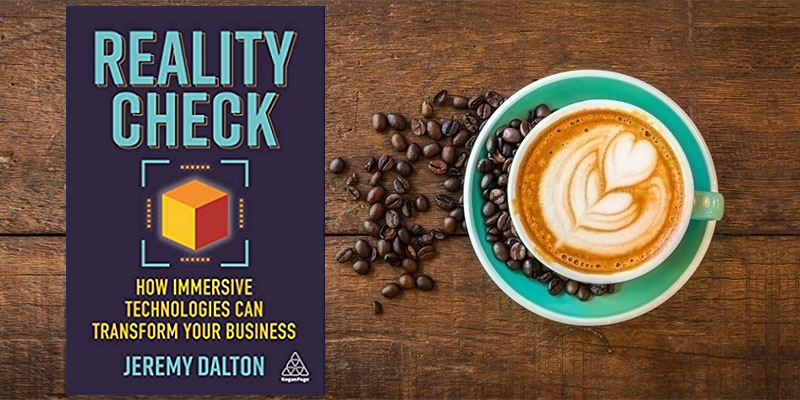Reality redefined: how VR and AR can enhance your business
This insightful book shares a wealth of frameworks and case studies of how immersive technologies can benefit a wide range of sectors.
Launched in 2012, YourStory's Book Review section features over 290 titles on creativity, innovation, knowledge work, and digital transformation. See also our related columns The Turning Point, Techie Tuesdays, and Storybites.
A range of immersive media applications is already delivering solid benefit to organisations across industry sectors, as chronicled in the book Reality Check: How Immersive Technologies can Transform your Business, by Jeremy Dalton.
The 14 chapters are well referenced, along with a five-page glossary of terms. Here are my key clusters of takeaways from this 240-page book, summarised as well in the table below. See also my reviews of the related books: The Inevitable, Innovation Ultimatum, Seeing Digital, and Data Story.
Based in London, Jeremy Dalton leads PwC's VR/AR team and helps customers understand, quantify, and implement the benefits of virtual reality and augmented reality technology.

Foundations
The author begins with a set of definitions and comparisons of VR and AR. AR presents an overlay of information on the real world, through a device like a mobile phone or headset; the digital elements may also be “anchored” to physical points.
AR digitally displays information to make sense of the physical world. It can reveal hidden information (eg. pipes behind a wall), and allow hands-free operation (eg. for surgery, mechanical repair).
“AR sacrifices full immersion for a direct connection to the physical world,” Jeremy explains. A limited form of AR is assisted reality, with a display screen for hands-free viewing – it does not have computer vision and the displayed information does not anchor to a physical object.
AR is part-digital, whereas VR immerses the user in a fully digital environment through a special headset or display. This environment can be computer-generated or recorded from the physical world (360-degree recording or 360 media).
VR helps understand environments that may be risky or costly to experience physically; it builds an emotional connection and frees users from distractions. It can scale up and down to better understand skyscrapers as well as molecules.
“VR offers the best of all worlds: the ability to create a believable, engaging, and easily repeatable scenario but without the associated cost, disruption or danger of the real thing,” Jeremy emphasises.
Together, VR and AR (extended reality, or XR) help in environmental and asset visualisation. This applies to engineering, architecture, interior design, retail, utilities, tourism, historical conservation, and journalism. Visualisation helps reduce mental overload, miscommunication, and misunderstanding.
XR is making clear impacts in the business world, but the media focuses more on consumer manifestations like gaming, Jeremy observes. One chapter addresses such myths and misunderstandings.
Some of these misconceptions include: XR is only for entertainment, it is an isolating technology, it will replace physical experiences, it is not scalable, it is too expensive, and it appeals only to younger generations.
Impacts
In business learning and development, VR helps in hard skills and soft skills training in contexts like usage of machinery, building customer empathy, diversity sensitivity, converting sales, and dealing with emergencies.
AR helps in remote assistance by knowledge sharing between experts and remote field workers, eg. in servicing equipment. DHL uses hands-free AR to improve efficiency, accuracy and training times of warehouse pickers. The UK NHS used AR to connect physicians to field staff during the COVID-19 pandemic.
VR in L&D has been used by Vodafone (to improve public speaking skills of employees, PwC (soft skills training for inclusive leadership), American Airlines (cabin crew procedures), Ford (reducing production line injury), Walmart (situational training), and Shell (emergency response training).
Operational uses of VR include AF Gruppen (visualising construction projects, collaborative design), HTC (industry conferences), and Cisco (visualise organisational social networks). VR has also been used to understand what may have happened in scenarios of an accident (UK courts) or disaster (flight crash).
PwC uses AR to visualise data published in reports. Promark-Telecon uses AR for infrastructure and utility visualisation.
In sales and marketing, AR helps consumers digitally “try on” personal items or visualise products in their environment before purchasing them. This reduces travel costs and is hygienic as well.
AR examples include Tissot (watch try on for window shoppers), UK Mail (parcel sizer), and Poizon (try on shoes), while O2 UK used VR to conduct research for optimising in-store marketing displays.
VR fully immerses customers in a simulated product experience. “VR is a powerful storytelling medium,” Jeremy emphasises.
Examples include TOMS (to describe its health initiatives in developing countries) and Jaguar (launch of electric cars). The world’s first product launch in AR was the OnePlus Nord in July 2020, according to Jeremy.
XR environments also constitute a new adverting channel, eg. National Geographic, Uber. In the design world, XR can help reduce cost and time in creating physical prototypes, increase speed to market, and enable alignment of design vision.
Implementing XR
From market research to impact analysis, the author describes five phases in implementing XR: discover, design, develop, deploy, and debrief.
XR can help address existing problems, and explore future opportunities. Success comes from an “explore, experiment, and engage” mindset, even in the face of criticism and ridicule.
Many successful products and business models of today were first ridiculed, eg. iPhone (scoffed at by Microsoft’s Steve Ballmer) and video-on-demand (dismissed by Blockbuster).
Technology and production
There are two chapters for readers interested in technology and XR content production. Content creation methods include computer generation, 360 video, and volumetric video. Volumetric video capture uses many pairs of cameras to create objects or scenes. Of the three methods, 360 video is more affordable, according to Jeremy.
He categorises XR hardware into four types: head-mounted displays, handheld devices, projection systems, and large screens. The three degrees of freedom (3 DoF) are up-down, left-right, and clockwise-anticlockwise.
On the other hand, ‘6 DoF’ goes further and tracks not just the device’s movement but its position. The user can move around the room and see the virtual objects from different angles.
The range of XR devices have differing implications of media modality, input channel, usability, accessibility, portability, privacy, security, and cost. Key issues to address are device management, maintaining headset hygiene, data quality, and production team coordination.
Some of the user experience challenges in VR can include a feeling of nausea or cyber-sickness, similar to motion sickness, the author cautions.
VR is an entirely new medium with new workflows and a whole new cinematic language that has not been defined yet, according to VR creator Alex Ruhl.
The road ahead
Though there may not be a clear “year of XR” with a major tipping point, Jeremy points to continuing trends in favour of XR such as dropping costs of storage, computing and broadband connectivity.
A number of platform providers, investors, and startups have entered the fray. Research on XR implementation and impact is gathering momentum, from product development to process improvement.
The author also identifies uses of XR outside the business world. For example, the Red Cross uses VR simulations for disaster response training. University of Leeds is researching VR use in dental education via simulation.
The refugee documentary Clouds over Sidra, produced by the UN and Samsung, leveraged VR to create powerful audience impacts that led to more fundraising.
“The video gaming industry is a force to be reckoned with – it is bigger than both music and film combined,” Jeremy observes.
Trends to watch include the rise of technologies like haptics and SLAM (simultaneous localisation and mapping), and business techniques like gamification. Smartphones are a boost to AR adoption, but not as much to VR due to low battery life.
The author profiles a number of startups and tech players in XR, such as Vyking, Blippar, Ubimax, VirtualSpeech, Quantified Design, ImmerseMe, Spearhead Interactive, Admix, and Gorilla in the Room.
In sum, the book provides an insightful and comprehensive overview of the rise of XR, with actionable frameworks and relevant case studies. It will be valuable for large firms as well as entrepreneurs looking for new venues of innovation.
YourStory has also published the pocketbook ‘Proverbs and Quotes for Entrepreneurs: A World of Inspiration for Startups’ as a creative and motivational guide for innovators (downloadable as apps here: Apple, Android).
Edited by Teja Lele














